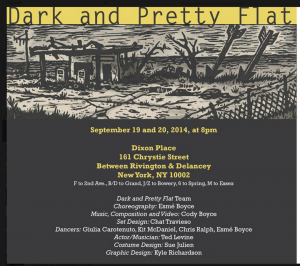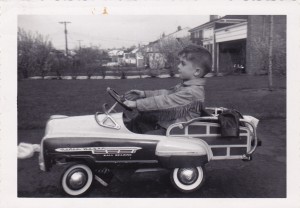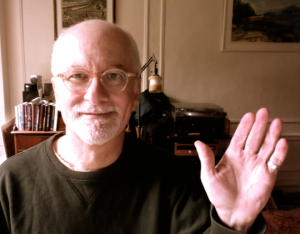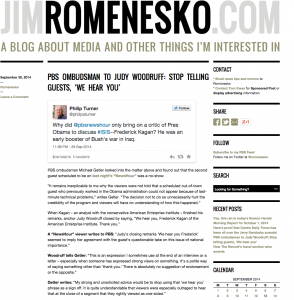New Search
If you are not happy with the results below please do another search
797 search results for: MG Turner
Creating Safer Streets in New York City
/0 Comments/in Bicycling, Urban Life & New York City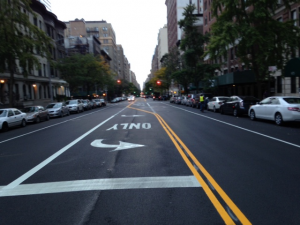 As a New Yorker who walks, bikes, and occasionally gets around in the city by taxi, I have been alarmed by the dangers on our streets and the numerous fatal encounters among pedestrians, bikers and cars. In August, I attended a public meeting held by NYC Council Member Helen Rosenthal, announcing potential changes to the local streets, designed by the Dept of Transportation to minimize these dangers, and “calm” vehicular traffic, as the planners put it. In the weeks since that meeting, West End Avenue has been freshly paved, and now new lane markers have been painted, which I hope will fundamentally alter the traffic flow, and improve the safety of all local residents. Please examine the screenshots below to see for yourself, or all the photos and charts via this link, which reveal the new design in its entirety. A key part of the plan boils down to dividing the 60-foot wide avenue differently than it’s been configured for many years. Rather than the avenue being divided in to six lanes each ten feet wide (with two of those lanes reserved for parking, and four lanes reserved for northbound and southbound traffic), the plan (view PDF here) will see the parking lanes on each side of the avenue widened to thirteen feet, the traffic lanes widened to eleven feet, and the creation of a center turning lane to allow for safer turns on to the neighborhood’s side streets. At some intersections, no turns from or on to side streets will be permitted.href=”http://philipsturner.com/wp-content/uploads/2014/10/SaferStreets-WEA.jpg”>
As a New Yorker who walks, bikes, and occasionally gets around in the city by taxi, I have been alarmed by the dangers on our streets and the numerous fatal encounters among pedestrians, bikers and cars. In August, I attended a public meeting held by NYC Council Member Helen Rosenthal, announcing potential changes to the local streets, designed by the Dept of Transportation to minimize these dangers, and “calm” vehicular traffic, as the planners put it. In the weeks since that meeting, West End Avenue has been freshly paved, and now new lane markers have been painted, which I hope will fundamentally alter the traffic flow, and improve the safety of all local residents. Please examine the screenshots below to see for yourself, or all the photos and charts via this link, which reveal the new design in its entirety. A key part of the plan boils down to dividing the 60-foot wide avenue differently than it’s been configured for many years. Rather than the avenue being divided in to six lanes each ten feet wide (with two of those lanes reserved for parking, and four lanes reserved for northbound and southbound traffic), the plan (view PDF here) will see the parking lanes on each side of the avenue widened to thirteen feet, the traffic lanes widened to eleven feet, and the creation of a center turning lane to allow for safer turns on to the neighborhood’s side streets. At some intersections, no turns from or on to side streets will be permitted.href=”http://philipsturner.com/wp-content/uploads/2014/10/SaferStreets-WEA.jpg”>
Now that the new lanes have been painted, I hope the city will quickly put in place public education and new signage, to make clear to drivers, pedestrians, and bikers how the new configuration is supposed to work. I am concerned that in the short term, the new markings will befuddle many people, leading to dangerous impatience and confusion. If you are an upper west sider, and want to know more about the efforts of Council Member Rosenthal and the DoT to improve safety, you may visit Rosenthal’s website, where you can submit your own suggestions. At Rosenthal’s site, you can also join her email list, to receive the many communications they forward from the DoT.
Autumn and the Little Red Lighthouse Festival 2014, an Ideal Combination
/0 Comments/in Bicycling, Books & Writing, Urban Life & New York CityBrisk winds and the aftermath of a rainy Friday night didn’t dampen the fun at the 22nd annual Little Red Lighthouse Festival this past Saturday, held on the grounds under the George Washington Bridge, aka the great gray bridge, near the Little Red Lighthouse, the last beacon light to shine in Manhattan. I have written about the landmark several times in recent years, including after I attended last year’s fall festival. The Parks Dept opens the lighthouse to visitors on these occasions, allowing New Yorkers to fully appreciate this splendid example of maritime architecture. After I toured the lighthouse last year, I wrote about its history and the children’s book that improbably helped to keep it standing on the shore of the Hudson: 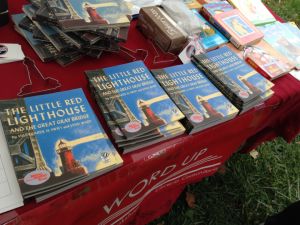
“If you’ve never had a close-up view of [the George Washington Bridge and the Little Red Lighthouse] and aren’t certain where they are or how to see them for yourself, we’re talking about upper Manhattan on the island’s west side roughly level with what would be West 178th Street and the Hudson River. I get there on my bike, pedaling on good pavement alongside the river most of the way from my neighborhood around West 100th Street and Riverside Drive. The area can also be reached from Washington Heights, near 181st Street, and in both cases it’s accessible to walkers as well as cyclists. The forty-foot tall lighthouse–whose exterior is dotted with porthole windows and decked out in bright red enameled paint with a white cone and clear glass at the top–sits below the lower deck of the bridge, close to the monumental steel foot of the span’s eastern arch. According to a NYC Parks Dept web page, the two structures became most indelibly linked in the public imagination in the early 1940s, and even earlier in the city’s maritime history. Here’s a lightly edited version of the Parks Dept. article:
‘In the early 20th century, barge captains carrying goods up and down the Hudson demanded a brighter beacon. The [lighthouse] had been erected on Sandy Hook, New Jersey in 1880, where it used a 1,000 pound fog signal and flashing red light to guide ships through the night. It became obsolete and was dismantled [but not destroyed or discarded] in 1917. In 1921, the U.S. Coast Guard reconstructed this lighthouse on Jeffrey’s Hook [future site of the George Washington Bridge] in an attempt to improve navigational aids on the Hudson River. Run by a part-time keeper and furnished with a battery-powered lamp and a fog bell, the lighthouse, then known as Jeffrey’s Hook Lighthouse [the name since the early 1800s for the shelf of Manhattan schist that juts out in to the river right there], was an important guide to river travelers for ten years. The George Washington Bridge opened in 1931, and the brighter lights of the bridge again made the lighthouse obsolete. In 1948, the Coast Guard decommissioned the lighthouse, and its lamp was extinguished.
‘The Coast Guard planned to auction off the lighthouse, but an outpouring of support for the beacon helped save it. The outcry from the public was prompted by the children’s book, The Little Red Lighthouse and the Great Gray Bridge, written by Hildegarde Swift and Lynd Ward in 1942. In the popular book, the Little Red Lighthouse is happy and content until a great bridge is built over it. In the end, the lighthouse learns that it still has an important job to do and that there is still a place in the world for an old lighthouse. The classic tale captured the imaginations of children and adults, many of whom wrote letters and sent money to help save the icon from the auction block.’
The Parks’ web page adds that in 1951 the Coast Guard gave the lighthouse and grounds to the City, and in 1979 the Little Red Lighthouse was officially added to the National Register of Historic Places. Refurbishments took place in 1986, when on the 65th anniversary the concrete foundation was restored, and in 2000 when it was repainted, true to its original shade of red.
In a real sense, the persistence of the lighthouse on the Manhattan shoreline is a product of one of the first episodes of “historic preservation” in the modern history of New York City. Too often, the city and posterity have been the loser in those battles, such as what occurred in 1963, when–unaccountably to current-day New Yorkers–the old Penn Station was torn down.”
I will add that it’s a great time for parks and historic sites in New York City, with such projects as the ongoing restoration of High Bridge, the footbridge that’s connected the Bronx and Manhattan since 1842, though it’s been derelict and off-limits to hikers for many years. Also heartening was the news last week that more than $130 million will be spent to upgrade and renovate thirty-five NYC parks that have historically been neglected, even while better known parks, like Central Park and Prospect Park, garner lots of resources.
I didn’t enter the Little Red Lighthouse on Saturday, as the line was long and I was glad to let others see it for the first time. I was just happy to walk the grounds and stop at the booths of several upper Manhattan organizations and businesses. Among these was the NYC Parks Dept, which sent several urban rangers to staff an information table; Summer on the Hudson, @summeronthehudson on Twitter, whose director Zhen Heinemann was on hand making sure everything ran smoothly; Word Up Books, “a completely volunteer run community bookshop, and arts space in Washington Heights,” on Amsterdam Ave at 165th Street, near the Morris-Jumel Mansion, the oldest wooden structure in Manhattan, built in 1765; graphic artist Norman Ibarra, who was selling a handsome poster he’s designed, printed on quality paper, that shows the seven lighthouses along the Hudson River, upstate from Athens and Saugerties south toward Manhattan and Jersey City; the National Lighthouse Museum, near the Staten Island Ferry terminal, whose representatives told me about the hoped-for restoration of the Old Orchard Beach lighthouse, wrecked during Hurricane Sandy; and Anthi’s Greek Specialities, a food vendor that was selling tasty spinach pie and baklava. Along with the above Facebook post I sent out that afternoon, I took lots of pictures during the festivities. Here are the best of them.
First Reviews of THE BIG BOOK OF SWASHBUCKLING ADVENTURE: “An Excellent Read” & “A Brilliant Selection of Dash, Pluck, Skill, Yearning, and Fortune.”
/0 Comments/in Books & Writing, Philip Turner Book ProductionsAnd now the second pre-publication review is in for The Big Book of Swashbuckling Adventure, selected and introduced by my author client Lawrence Ellsworth, another very positive notice. It comes from Publishers Weekly, who commissioned author William Dietrich to review the anthology. Dietrich’s piece closes with this encomium: “Ellsworth offers the reader an excellent and entertaining survey of the genre’s roots, a brilliant selection of dash, pluck, skill, yearning, and fortune.” See below for more details on the book, and the first review, which came in last week. Thanks to Pegasus Books for preparing the handsome edition and congrats to editor Lawrence Ellsworth. There will be finished copies of the book in November. It’s setting up very nicely!
—
I first posted about this book project when I began presenting it to publishers in March 2013, and am delighted that Pegasus Books acquired it. They’re an independent press whose titles are sold to bookstores by W.W. Norton. Pegasus has done a great job getting the anthology ready for publication. You can see their catalog listing for the book via this link (or in the screenshot below). Yesterday, I was delighted to see the first review of it, by Cindy A. Matthews at Authorlink, which I quickly shared in its entirety on Facebook (embedded below). In the catalog copy, you’ll note an interesting sidelight about my author client Lawrence Ellsworth, who conceived of the anthology, selected all the pieces, wrote the introductions, and translated the Alexander Dumas selection that’s in the book: he was an original team member of the group that created the legendary role-playing game Dungeons and Dragons. The oversized quality paperback, illustrated with art from the heady period when these stories were originally published, between the 1870s-1920s, will make a great holiday gift. 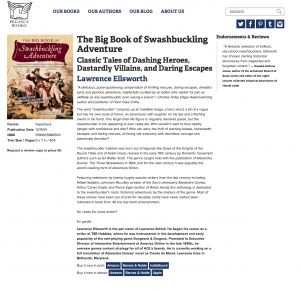
What’s Keeping Me Busy These Days
/0 Comments/in Personal History, Family, Friends, Education, Travels, Philip Turner Book ProductionsFor any readers who’ve been wondering about the relative (in)frequency of my recent posts here and on Honourary Canadian, I want to explain that since Labor Day my business, Philip Turner Book Productions, has gone full bore and I am busy with such paying assignments as reading and reporting on a suspense novel for an author who hired me to assess his manuscript; editing the professional memoir of a retired corporate executive; editing website copy for a financial and retirement planner; meeting with the operations director of a website to discuss me providing book-related content for them; as an agent, I’m working on the contract for a Spanish novelist whose book I recently licensed to a US publisher; and pitching a terrific pirate-themed trilogy that’s already a self-publishing success, to major US publishers. I love writing and curating the two blogs, but they sometimes take a back seat to other work, especially work that is directly remunerative.
And in honor of Autumn, and the Winter that is surely coming, I’ve grown back my goatee, a facial accoutrement I’ve maintained periodically over the years.
Thanks, as always, for checking back here to see what is new, or for that matter, what’s old—in the three years I’ve been writing these blogs, I’ve published almost 900 posts, so there’s bound to be material you haven’t noticed before, on books, publishing, media, music, culture, and current affairs. Also, remember to look for me on Twitter where my handle is @philipsturner, on Facebook, on LinkedIn, and the other social networks shown at the top right corner of this site.
In Which My Critique of PBS NewsHour for Letting Architect of Iraq War Spew Invective at President Obama Gets Wide Coverage
/0 Comments/in Media, Blogging, InternetFor a media hound like me, Jim Romenesko’s media news website is a regular must-read. Imagine the satisfaction I felt today when I saw he’d done a post yesterday that used a tweet of mine from Monday night—about a shockingly one-sided PBS Newshour segment about ISIS and President Obama—as the jumping-off point for his piece. In the segment, Judy Woodruff interviewed Frederick Kagan, an early proponent of invading Iraq, who slammed President Obama repeatedly for his supposed failures with regard to Iraq, including the bogus canard that he failed to leave US troops in the country, when it was the Bush administration that negotiated the terms under which US forces left. This and many other false and tendentious claims were made by Kagan of the American Enterprise Institute, all of which went unchallenged by interviewer Judy Woodruff. Worse, at the end of the segment she said, “We hear you,” as if lending her stamp of approval to Kagan’s screed. I was appalled at this egregious example of biased coverage and tweeted to that effect. Today, Romenesko ran a post picking up my tweet, and for which he interviewed PBS ombudsman Michael Getler, who’s also covered this episode. Getler agreed that the segment was an example of terrible and one-sided coverage. Getler learned that the program had planned for another guest to be on opposite Kagan, but that they couldn’t come on, after all. The NewsHour never told viewers this on-air. Below is a screenshot to Romenesko’s post, and here’s a link to it.
One More Time—A Happy Hobbit Birthday!
/4 Comments/in Books & Writing, Personal History, Family, Friends, Education, TravelsI published the piece below two years ago on this date, my birthday. I’m happy to share it here again today, as I turn 60!
As this day, September 22, 2012, stretches toward midnight, it happens to have been my 58th birthday. Growing up, of course I always enjoyed this day, but as I prepared to turn 13 back in 1967, my appreciation of my own birthday had taken a new turn. For earlier that year I first read the work of J.R.R. Tolkien and discovered that all the key action in The Hobbit, and the first book of “The Lord of the Rings” trilogy, The Fellowship of the Ring, was triggered at the birthday parties of Bilbo Baggins,and his nephew Frodo Baggins. And for reasons unknown to me—and so far as I know, never analyzed in all the criticism on Tolkien and Middle Earth—the birthday of uncle and nephew Baggins was September 22. The sharing of my birthday with the brave and indefatigable hobbits was a source of great strength to me during my adolescence. When difficult times arose, I took comfort in the knowledge that I had some sort of kinship with the creative imaginings of such a great writer as Tolkien. His books have been with me at many junctures in my life. Seeing Tolkien’s hobbit protagonists at the center of his sagas made me believe I could be at the center of my own life narrative.
I’ve always liked the fact that the Jewish new year, Rosh Hashana, falls around roughly the same time as my birthday. This year it was just last week. I like that the new year is said to begin in autumn–counter-intuitively–just as life in nature is beginning to fade and die. It sobers one up a bit, reminding us all that we’re not here forever. I don’t need too much reminding of that fact, in as much as starting in my late 30s I lost my father, then in my 40s, two best friends from college—Rob Adams and Karl Petrovich—and in my 50s, my mom and then my brother, Joel. Still, it seems salutary to take note of the leaves falling just as we prepare the turn of another year, as well as the turn from summer into fall.
With Tolkien in mind, my observance of my own birthday this year got off to a good start yesterday when I saw in Shelf Awareness, the bookselling daily e-newsletter, that Tolkien’s US publisher is publishing a new edition of The Hobbit, tying in with Peter Jackson’s movie adaptation of “The Lord of the Rings” prequel, premiering December 14. When the movie opens in a few months, I’ll sort of feel as if it’s almost again, albeit out of season. Meantime, today’s been a good day, thanks to family, friends, and J.R.R. Tolkien.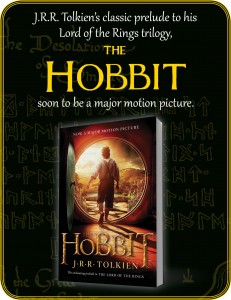
Carving Space w/Esme Boyce Dance in “Dark and Pretty Flat”
/0 Comments/in Art, Film, TV, Photography, Fine Printing & Design, Personal History, Family, Friends, Education, Travels, Urban Life & New York City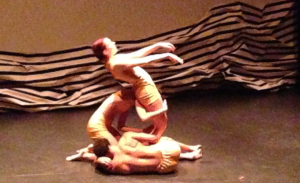 Had an enjoyable time last night at “Dark and Pretty Flat,” a dance performance and multimedia presentation put on by Esmé Boyce Dance. The series of eight linked pieces flowed seamlessly from one to the next against a rolling video backdrop, of wooded roadsides and watery depths; atmospheric guitar playing, both live and looped; and spoken word poetry. The four dancers, in costumes that bore a wood grain texture in gray and peach hues, were sometimes on the floor all together, in pairs, or solo. Carving space with their articulate arms, hands, fingers, legs, feet, and toes, they supplely shifted their weight in to rolls across the floor and shoulder tucks that brought them in to very near proximity with their own torsos, or those of fellow dancers. It was a world premiere, with all the pieces choreographed by Esmé Boyce. Beside directing her eponymous company, she collaborates with the Satellite Collective and is a member of Janis Brenner & Dancers. Other collaborators were: video artist Cody Boyce, Esmé’s brother, music and poetry; actor Ted Levine, reader; architectural designer Chat Travieso, set designer; artist Sue Julien, the two Boyce’s mother, costume designer—she chose the wood grain fabric, and cut the costumes as supplely as the dancers moved.
Had an enjoyable time last night at “Dark and Pretty Flat,” a dance performance and multimedia presentation put on by Esmé Boyce Dance. The series of eight linked pieces flowed seamlessly from one to the next against a rolling video backdrop, of wooded roadsides and watery depths; atmospheric guitar playing, both live and looped; and spoken word poetry. The four dancers, in costumes that bore a wood grain texture in gray and peach hues, were sometimes on the floor all together, in pairs, or solo. Carving space with their articulate arms, hands, fingers, legs, feet, and toes, they supplely shifted their weight in to rolls across the floor and shoulder tucks that brought them in to very near proximity with their own torsos, or those of fellow dancers. It was a world premiere, with all the pieces choreographed by Esmé Boyce. Beside directing her eponymous company, she collaborates with the Satellite Collective and is a member of Janis Brenner & Dancers. Other collaborators were: video artist Cody Boyce, Esmé’s brother, music and poetry; actor Ted Levine, reader; architectural designer Chat Travieso, set designer; artist Sue Julien, the two Boyce’s mother, costume designer—she chose the wood grain fabric, and cut the costumes as supplely as the dancers moved.
The performance was at a lower east side combined theater and bar venue Dixon Place, a new one to me. Entering at 161A Chrystie St, between Rivington and Delancey, you walk in on a narrow bar, while small tables, chairs and sofas and a tiny stage are in the back. In that rear area is a stairway down to the basement where there’s a large theater, with upwards of 50 seats in banked rows. As a New Yorker for nearly thirty years, it still fascinates me to discover spaces like this, caverns tucked away beneath the rumbling streets and subways, renovated and built out for creative endeavors. The establishment has a great vibe, whether upstairs or down. It was particularly nice to see Kit Boyce, friend of many years, husband of Sue Julien, father to Esmé and Cody, friends who I first met in Chicago, in the years I regularly went there to visit Franconia College classmate Robert Henry Adams.
After the dances, the full house walked back up the stairs for an instant after party in the bar and seating area. Bouquets were presented to the dancers—Esmé’s mates were Giulla Carotenuto, Kit McDaniel, and Christopher Ralph—and toasts were offered all ’round. I hadn’t been to a dance performance in years, and I found it an aesthetic pleasure to see movement, color, fabric, sound, and light all played to such intriguing effect. There’s one more performance of “Dark and Pretty Flat” tonight. I recommend it highly, or take yourself out to some dance soon.